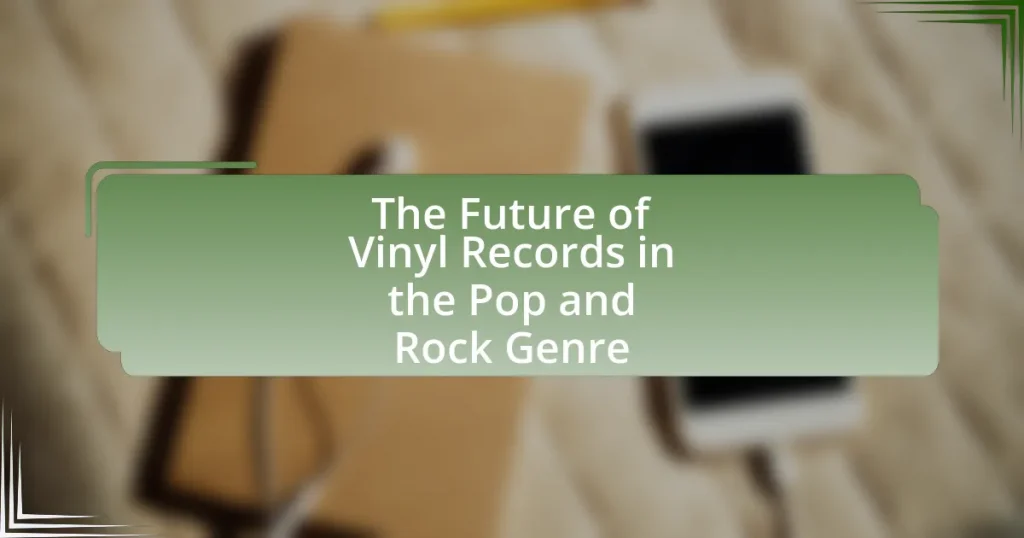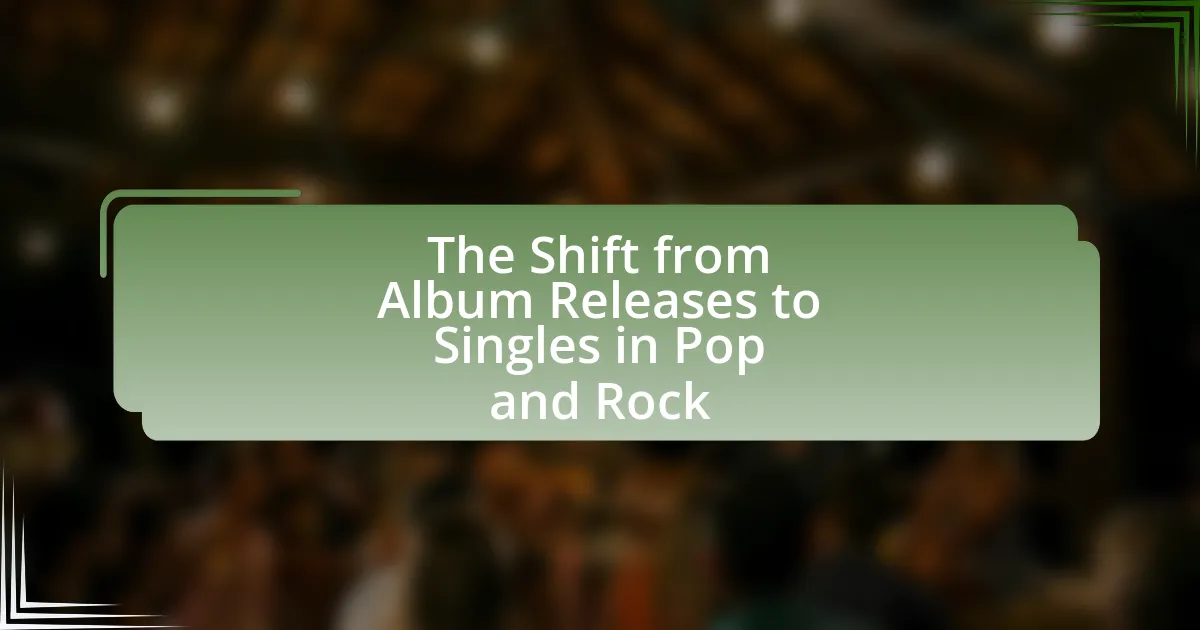The article examines the current state and future of vinyl records within the pop and rock genre, highlighting a significant resurgence in popularity as vinyl sales surpassed CD sales in the United States for the first time since the 1980s. Key factors contributing to this trend include a growing consumer preference for analog sound quality, the tactile experience of physical media, and the nostalgic appeal of vinyl. The article also discusses the role of artists and labels in promoting vinyl, the impact of technological advancements on production, and the cultural implications of vinyl in music consumption. Additionally, it addresses challenges facing the vinyl industry and explores emerging trends, sustainability efforts, and practical tips for collectors.
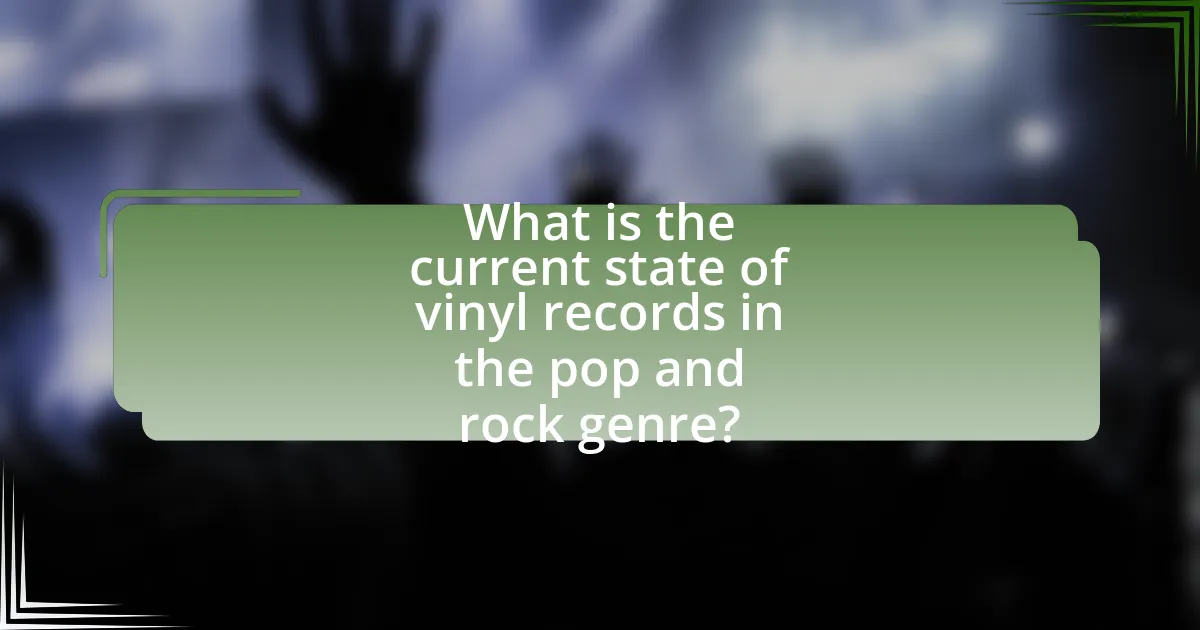
What is the current state of vinyl records in the pop and rock genre?
The current state of vinyl records in the pop and rock genre is one of significant resurgence and popularity. In 2022, vinyl sales in the United States surpassed CD sales for the first time since the 1980s, with vinyl accounting for 41 million units sold compared to 33 million CDs, according to the Recording Industry Association of America (RIAA). This trend reflects a growing consumer preference for physical formats and the unique audio experience that vinyl provides, particularly among younger listeners who appreciate the tactile and nostalgic aspects of record collecting. Additionally, major artists in the pop and rock genres are increasingly releasing new albums on vinyl, further solidifying its status in the music industry.
How has the popularity of vinyl records changed over the years?
The popularity of vinyl records has experienced a significant resurgence since the early 2000s. After a decline in the late 20th century due to the rise of digital music formats, vinyl sales began to increase dramatically, with the Recording Industry Association of America (RIAA) reporting that vinyl sales surpassed CD sales in revenue for the first time in 2020. This revival is attributed to factors such as the tangible nature of vinyl, the appeal of album artwork, and a growing interest in analog sound quality among music enthusiasts. Additionally, in 2021, vinyl records accounted for 27% of all physical music sales in the United States, highlighting their renewed popularity in the music industry.
What factors have contributed to the resurgence of vinyl records?
The resurgence of vinyl records is primarily driven by a growing consumer preference for analog sound quality and the tangible nature of physical media. This trend is supported by statistics indicating that vinyl sales in the United States reached 41.7 million units in 2020, marking the highest sales since 1986, according to the Recording Industry Association of America (RIAA). Additionally, the nostalgic appeal of vinyl, combined with the rise of independent record stores and a culture that values unique and collectible items, has further fueled interest. The experience of listening to vinyl, which often includes larger album artwork and the ritual of playing records, enhances its allure among music enthusiasts.
How do sales figures for vinyl compare to digital formats?
Sales figures for vinyl records have seen a significant resurgence, often outperforming digital formats in specific contexts. In 2022, vinyl sales in the United States reached 41 million units, marking the highest level since the 1980s, while digital downloads continued to decline, with a drop of 12.5% in the same year. This trend indicates a growing consumer preference for physical media, particularly among collectors and enthusiasts, contrasting with the convenience-driven digital format. The Recording Industry Association of America (RIAA) reported that vinyl revenue surpassed CD revenue for the first time since the 1980s, highlighting a shift in market dynamics favoring vinyl over digital formats.
What role do vinyl records play in the music industry today?
Vinyl records play a significant role in the music industry today as a symbol of nostalgia and a preferred medium for audiophiles. The resurgence of vinyl sales, which reached 41 million units in the U.S. in 2022, indicates a growing consumer preference for physical formats over digital streaming. This trend is particularly strong among younger generations, with 18-24-year-olds accounting for 27% of vinyl sales, demonstrating that vinyl is not just a relic but a contemporary choice for music consumption. Additionally, artists and labels are increasingly releasing new albums on vinyl, recognizing its value in creating a tangible connection with fans and enhancing the overall listening experience.
How do artists and labels view vinyl records in their marketing strategies?
Artists and labels view vinyl records as a vital component of their marketing strategies, leveraging the format’s nostalgic appeal and tangible nature to enhance brand identity and consumer engagement. The resurgence of vinyl sales, which reached 41 million units in the U.S. in 2022, demonstrates its effectiveness in creating a unique selling proposition that differentiates artists in a crowded digital marketplace. By offering limited edition releases and exclusive artwork, artists and labels capitalize on vinyl’s collectible status, fostering a deeper emotional connection with fans and driving merchandise sales. This strategic focus on vinyl not only reinforces an artist’s image but also taps into the growing consumer trend favoring physical media over digital formats.
What impact does vinyl have on music consumption trends?
Vinyl has significantly influenced music consumption trends by driving a resurgence in physical media sales and enhancing the listening experience. In recent years, vinyl sales have outpaced digital downloads, with the Recording Industry Association of America reporting that vinyl records generated over $1 billion in revenue in 2022, marking the highest level since the 1980s. This trend indicates a growing consumer preference for tangible music formats, as vinyl offers a unique auditory and aesthetic experience that digital formats cannot replicate. Additionally, the revival of vinyl has led to increased interest in album artwork and packaging, further solidifying its role in contemporary music culture.
What are the cultural implications of vinyl records in pop and rock music?
Vinyl records have significant cultural implications in pop and rock music, serving as a symbol of authenticity and nostalgia. The resurgence of vinyl in recent years, with sales reaching over 41 million units in the U.S. in 2020, highlights a collective desire for tangible music experiences amidst digital consumption. This revival reflects a cultural shift towards valuing the physicality of music, where album artwork and the ritual of playing a record enhance the listening experience. Furthermore, vinyl records foster a sense of community among collectors and enthusiasts, creating spaces for social interaction and shared appreciation of music history. The cultural implications are evident in how vinyl has become a medium for artistic expression, with artists often releasing special editions that resonate with fans on a deeper emotional level.
How do vinyl records influence the listening experience for fans?
Vinyl records significantly enhance the listening experience for fans by providing a warmer, richer sound quality compared to digital formats. This analog medium captures a broader frequency range and dynamic range, resulting in a more immersive auditory experience. Studies have shown that many listeners perceive vinyl as having a more authentic and engaging sound, which can evoke nostalgia and emotional connections to the music. Additionally, the tactile nature of handling vinyl records, including the large album artwork and the ritual of playing a record, contributes to a more intentional and focused listening experience. This engagement is supported by a resurgence in vinyl sales, with the Recording Industry Association of America reporting that vinyl sales surpassed CD sales in 2021 for the first time since the 1980s, indicating a strong preference among fans for the unique qualities of vinyl records.
What communities have formed around vinyl collecting?
Communities that have formed around vinyl collecting include online forums, social media groups, and local record clubs. Online platforms like Reddit and Facebook host dedicated groups where collectors share their finds, discuss pressing details, and exchange tips on maintaining vinyl. Local record clubs often organize meetups, allowing members to trade records and attend listening parties, fostering a sense of camaraderie among enthusiasts. Additionally, events such as Record Store Day have created a communal atmosphere, bringing together collectors and artists to celebrate vinyl culture. These communities contribute to the resurgence of vinyl, evidenced by the 2022 statistic that vinyl sales surpassed CD sales in the U.S. for the first time since the 1980s, highlighting the growing interest and engagement within these groups.
How are technological advancements affecting vinyl records?
Technological advancements are enhancing the production and distribution of vinyl records, leading to improved sound quality and accessibility. Innovations such as high-resolution digital mastering techniques allow for more precise audio reproduction, resulting in richer soundscapes. Additionally, advancements in vinyl pressing technology, including the use of better materials and automated processes, have increased the consistency and durability of records. According to a report by the Recording Industry Association of America, vinyl sales reached a 30-year high in 2020, indicating a resurgence in popularity partly driven by these technological improvements.
What are the challenges facing the vinyl record industry?
The vinyl record industry faces several challenges, including supply chain issues, rising production costs, and competition from digital formats. Supply chain disruptions, particularly during the COVID-19 pandemic, have led to delays in manufacturing and shipping, impacting availability. Additionally, the cost of raw materials, such as vinyl and packaging, has increased, which can lead to higher retail prices for consumers. Furthermore, the dominance of streaming services continues to pose a significant challenge, as many consumers prefer the convenience of digital music over physical formats. According to the Recording Industry Association of America, while vinyl sales have seen a resurgence, they still represent a small fraction of overall music consumption, highlighting the ongoing competition with digital platforms.
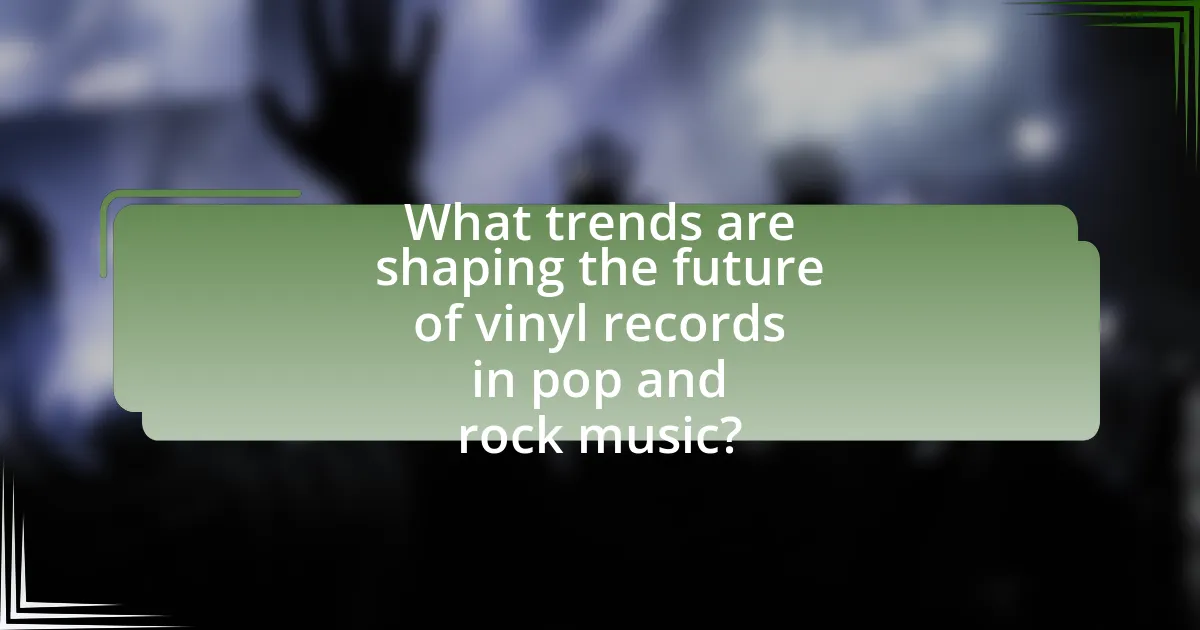
What trends are shaping the future of vinyl records in pop and rock music?
The future of vinyl records in pop and rock music is being shaped by a resurgence in consumer interest, driven by nostalgia and the unique audio experience vinyl provides. Sales of vinyl records have seen a significant increase, with the Recording Industry Association of America reporting that vinyl sales surpassed CD sales in 2020 for the first time since the 1980s. This trend is further supported by the growing number of independent record stores and vinyl pressing plants, which cater to the rising demand. Additionally, artists are increasingly releasing special editions and colored vinyl, enhancing collectibility and appealing to fans. The integration of vinyl into streaming culture, where artists promote their vinyl releases alongside digital formats, also contributes to its sustained popularity.
How are new artists incorporating vinyl into their releases?
New artists are incorporating vinyl into their releases by producing limited edition pressings that appeal to collectors and fans. This trend is evident as vinyl sales have surged, with the Recording Industry Association of America reporting that vinyl sales reached 41 million units in 2022, the highest level since the 1980s. Additionally, many new artists are using vinyl to create a tangible connection with their audience, often including unique artwork, colored vinyl, and exclusive tracks that are not available in digital formats. This strategy not only enhances the listening experience but also capitalizes on the growing nostalgia for physical media among music enthusiasts.
What innovative packaging and design trends are emerging in vinyl records?
Innovative packaging and design trends emerging in vinyl records include the use of eco-friendly materials, intricate artwork, and unique formats. Eco-friendly packaging is gaining traction as artists and labels prioritize sustainability, utilizing recycled materials and biodegradable options. Additionally, intricate artwork and gatefold designs are becoming more prevalent, enhancing the visual appeal and collectible nature of vinyl records. Unique formats, such as picture discs and colored vinyl, are also on the rise, appealing to collectors and fans alike. These trends reflect a broader movement towards personalization and artistic expression in the vinyl market, aligning with consumer preferences for distinctive and environmentally conscious products.
How are streaming services influencing vinyl record production?
Streaming services are significantly influencing vinyl record production by driving demand for physical formats among consumers who seek a tangible connection to music. As streaming platforms like Spotify and Apple Music provide instant access to vast music libraries, they have also sparked a resurgence in vinyl sales, with the Recording Industry Association of America reporting that vinyl sales reached a 30-year high in 2020, surpassing CD sales for the first time since the 1980s. This trend indicates that while digital streaming dominates music consumption, it simultaneously enhances the appeal of vinyl records as collectors’ items and as a nostalgic medium, prompting record labels to invest more in vinyl production to meet this growing consumer interest.
What role does sustainability play in the future of vinyl records?
Sustainability is crucial for the future of vinyl records as it addresses environmental concerns associated with traditional production methods. The vinyl manufacturing process typically involves petroleum-based materials, which contribute to pollution and resource depletion. In response, the industry is increasingly adopting eco-friendly practices, such as using recycled materials and renewable energy sources. For instance, companies like Vinyl Me, Please are exploring sustainable vinyl production techniques, which can reduce carbon footprints and waste. This shift not only meets consumer demand for environmentally responsible products but also aligns with broader trends in the music industry towards sustainability, ensuring the longevity and relevance of vinyl records in a changing market.
How are manufacturers addressing environmental concerns in vinyl production?
Manufacturers are addressing environmental concerns in vinyl production by adopting sustainable practices and materials. For instance, some companies are using bio-based plastics and recycled materials to create vinyl records, which significantly reduces the carbon footprint associated with traditional vinyl production. Additionally, manufacturers are implementing cleaner production processes that minimize waste and energy consumption. According to a 2021 report by the Vinyl Sustainability Council, these initiatives have led to a 30% reduction in greenhouse gas emissions in the vinyl manufacturing sector over the past five years.
What alternatives to traditional vinyl are being explored?
Alternatives to traditional vinyl being explored include eco-friendly materials such as recycled plastics, bioplastics, and even wood-based substrates. Research indicates that these materials can reduce environmental impact while maintaining sound quality. For instance, bioplastics derived from renewable resources like cornstarch are being tested for their potential to replace petroleum-based vinyl, offering a sustainable option without compromising audio fidelity.
What predictions can be made about the future of vinyl records?
Vinyl records are predicted to continue their resurgence in popularity, driven by a growing appreciation for analog sound quality and the tangible nature of physical media. Sales data from the Recording Industry Association of America (RIAA) indicates that vinyl sales reached a 30-year high in 2022, surpassing CD sales for the first time since the 1980s. This trend suggests that vinyl records will maintain a strong presence in the music market, particularly among collectors and audiophiles. Additionally, the rise of vinyl pressing plants and the expansion of vinyl releases from both established and emerging artists indicate a sustained commitment to this format, further solidifying its future in the pop and rock genres.
How might consumer preferences evolve in the coming years?
Consumer preferences are likely to evolve towards a greater appreciation for vinyl records in the pop and rock genre, driven by nostalgia and the desire for tangible music experiences. Recent trends indicate a resurgence in vinyl sales, with the Recording Industry Association of America reporting that vinyl sales surpassed CD sales in 2020 for the first time since the 1980s. This shift reflects a growing consumer preference for physical formats that offer a unique auditory experience and aesthetic value. Additionally, younger generations are increasingly drawn to vinyl for its perceived authenticity and the ritualistic aspect of playing records, further solidifying its place in the music market.
What potential markets could emerge for vinyl records?
Potential markets for vinyl records include the growing demand among younger consumers, particularly millennials and Gen Z, who seek tangible music experiences. This demographic has shown a significant interest in vinyl, with sales increasing by 29% in 2020, according to the Recording Industry Association of America. Additionally, niche markets such as limited edition releases, artist collaborations, and custom pressings are emerging, catering to collectors and audiophiles. The resurgence of vinyl in the context of home decor and lifestyle branding also presents opportunities, as consumers integrate vinyl records into their living spaces as aesthetic elements. Furthermore, the rise of subscription services offering curated vinyl selections could tap into the convenience and novelty sought by modern consumers.
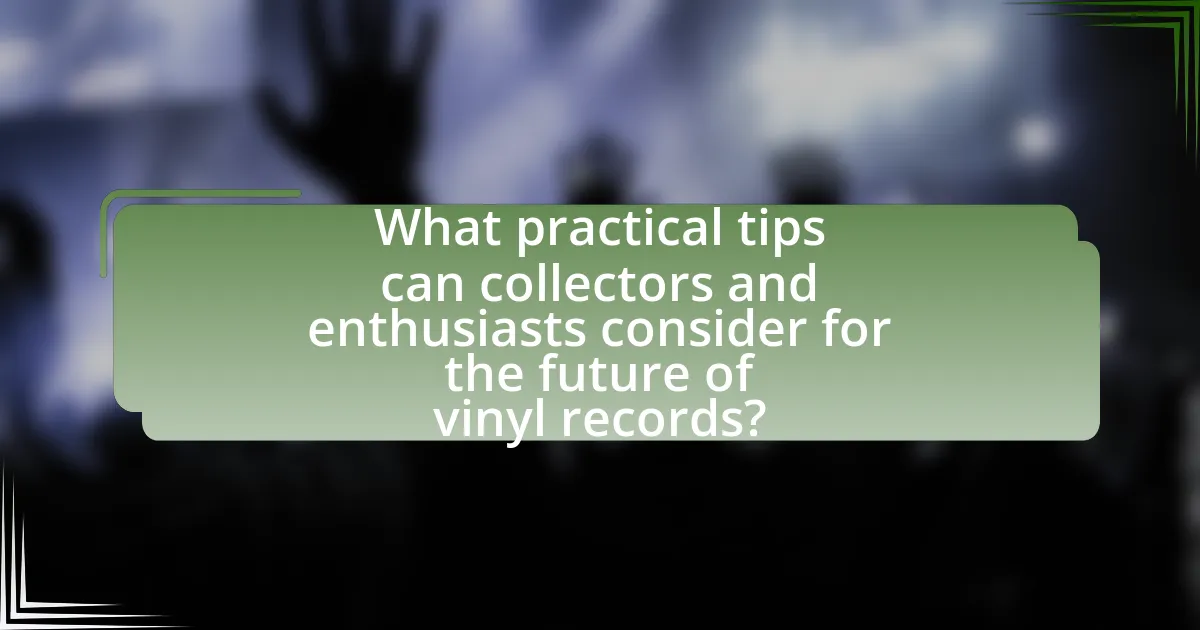
What practical tips can collectors and enthusiasts consider for the future of vinyl records?
Collectors and enthusiasts should prioritize proper storage and maintenance of vinyl records to ensure their longevity. Storing records vertically in a cool, dry environment protects them from warping and dust accumulation. Additionally, using anti-static sleeves and cleaning records regularly with appropriate solutions can prevent scratches and preserve sound quality. According to a 2021 report by the Recording Industry Association of America, vinyl sales reached a 30-year high, indicating a growing interest in the medium, which underscores the importance of caring for records to maintain their value and enjoyment.
How can collectors ensure the longevity of their vinyl collections?
Collectors can ensure the longevity of their vinyl collections by properly storing and handling the records. Storing vinyl records vertically, away from direct sunlight and extreme temperatures, prevents warping and fading. Additionally, using anti-static sleeves protects the records from dust and scratches, which can degrade sound quality. Research indicates that maintaining a stable environment with humidity levels between 40-50% significantly reduces the risk of damage to vinyl records. Regularly cleaning records with appropriate cleaning solutions and tools also preserves their condition and sound integrity.
What best practices should be followed for storing and maintaining vinyl records?
To store and maintain vinyl records effectively, keep them upright in a cool, dry environment away from direct sunlight. This practice prevents warping and fading, which can degrade sound quality. Additionally, use anti-static inner sleeves to protect the records from dust and scratches, as dust accumulation can cause surface noise and damage during playback. Regularly clean records with a carbon fiber brush or a dedicated vinyl cleaning solution to remove debris and preserve audio fidelity. Research indicates that maintaining a stable temperature between 65-70°F and humidity levels around 40-50% significantly extends the lifespan of vinyl records.
How can collectors stay informed about new releases and trends?
Collectors can stay informed about new releases and trends by subscribing to industry newsletters, following social media accounts of record labels and artists, and participating in online forums dedicated to vinyl collecting. These methods provide timely updates on upcoming releases and market trends. For instance, platforms like Discogs and Vinyl Me, Please offer newsletters that highlight new vinyl releases and trends in the pop and rock genres, ensuring collectors have access to the latest information. Additionally, social media platforms like Instagram and Twitter allow collectors to engage directly with artists and labels, further enhancing their awareness of new developments in the vinyl market.
